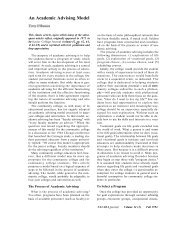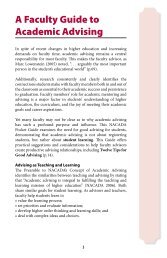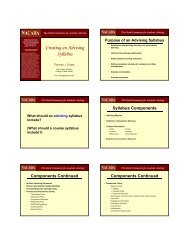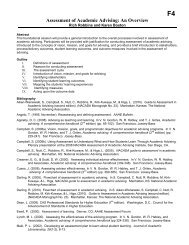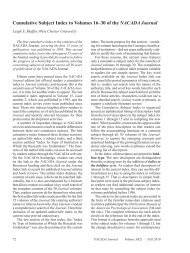The Advising Counseling Continuum: Triggers for Referral - NACADA
The Advising Counseling Continuum: Triggers for Referral - NACADA
The Advising Counseling Continuum: Triggers for Referral - NACADA
Create successful ePaper yourself
Turn your PDF publications into a flip-book with our unique Google optimized e-Paper software.
<strong>Advising</strong> <strong>Referral</strong> <strong>Triggers</strong>Some of the confusion in terminology may stemfrom the widespread use of the term counseling insecondary schools; it covers the gamut of responsibilitiesfrom dispensing in<strong>for</strong>mation to dealing withstudents’ emotional and behavioral problems. Bytheir very nature, advisors and counselors experienceconsiderable overlap between their responsibilities,attesting to an institutional lack of agreement aboutthe responsibilities associated with either position.For the sake of clarity, we use the terms advising andadvisor to refer to academic advising and academicadvisor. <strong>The</strong> terms counseling and counselor refer tothose who are trained in a graduate-level program toprovide personal counseling and the services theyprovide; counselors may be housed in a college or ina counseling center. <strong>The</strong> roles of advisor and counselorare more robust than the characterizations in thisarticle; nevertheless, the distinctions between advisingand counseling are made intentionally stark toemphasize their differences. This article is most pertinentto colleges and universities in which the rolesof advisor and counselor are distinct, unlike the situationsat many community colleges where bothroles may be invested in the same person with atitle of either advisor or counselor.<strong>The</strong> <strong>Advising</strong>-<strong>Counseling</strong> <strong>Continuum</strong>Having noted the widespread ambiguity, overlap,and lack of agreement in the current use of the termsadvising and counseling, we conceived a continuumof responsibilities addressed by both advisorsand counselors in varying degrees. This continuumof responsibilities is represented in Table 1 andincludes five different levels of involvement: in<strong>for</strong>mational,explanatory, developmental, mentoring,and counseling. While the table columns that illustratethe five levels of involvement may be mistakenlyperceived as silos, we realize that in manycircumstances involvement may not be characterizedneatly in categories. In practice, the levels of involvementmay overlap, and each column represents adevelopmental component that empowers adviseesto discuss themselves, their feelings, and their goals.Shane (1981) compared advising, counseling,and psychotherapy and outlined the service providersand program categories <strong>for</strong> each. Butler (1995)identified the missions and purposes of organizationalstructures and services <strong>for</strong> advising and counseling.<strong>The</strong> first version of the content in Table 1 wasdeveloped by Virginia Gordon <strong>for</strong> workshops inthe 1970s and has been revised to reflect the contentof this article. Table 1 may be considered afurther development of those earlier ef<strong>for</strong>ts.<strong>The</strong> purpose, content, and focus of academicadvising contacts range from students’simple questionsto more complex academic, social, or personalproblems. All advisors tend to be involved in thein<strong>for</strong>mational, explanatory, and developmental-advisingresponsibilities (Table 1), but faculty advisors aremore likely to assume the role of mentor with graduatestudents or undergraduates in liberal arts institutions.<strong>The</strong> questions or concerns that studentspresent in the advising contact determine the involvementof the advisor, and some contacts may engagethe advisor at multiple levels: <strong>The</strong> student may needbasic in<strong>for</strong>mation, a clarification of some aspect ofthat in<strong>for</strong>mation, and help in applying and integratingit into her or his personal situation.In<strong>for</strong>mational <strong>Advising</strong><strong>The</strong> least complex level of advising involvesthe simple act of providing in<strong>for</strong>mation. It includes,<strong>for</strong> example, the advisor answering basic questionspertaining to directions and assignments, or whenno complicating factors exist, it may include advisor-initiatedreferrals of students to campus locationsor individuals. An advisor may respond to astudent who is requesting basic in<strong>for</strong>mation by E-Table 1 <strong>The</strong> advising-counseling responsibility continuum<strong>The</strong> <strong>Continuum</strong>Session In<strong>for</strong>mational Explanatory Developmental Mentoring <strong>Counseling</strong>Purpose In<strong>for</strong>mational Clarification Insights Growth Pinpoint problemContent In<strong>for</strong>mation Procedures Options and Values Devise resolutionvaluesFocus <strong>The</strong> <strong>The</strong> <strong>The</strong> student <strong>The</strong> person Modification ofin<strong>for</strong>mation institution student’s behaviorLength of each 5–15 15–30 30–60 Varies; many Determined bycontact (minutes) contacts are severity ofmade problem<strong>NACADA</strong> Journal Volume 26 (1) Spring 2006 25



